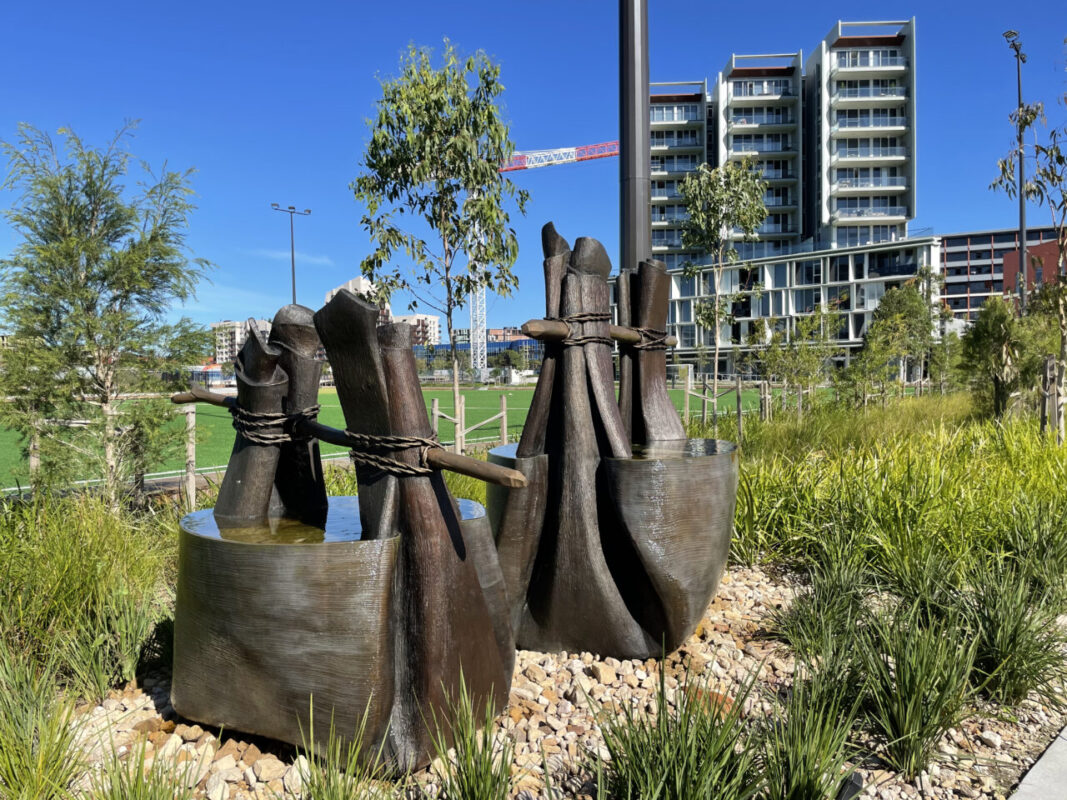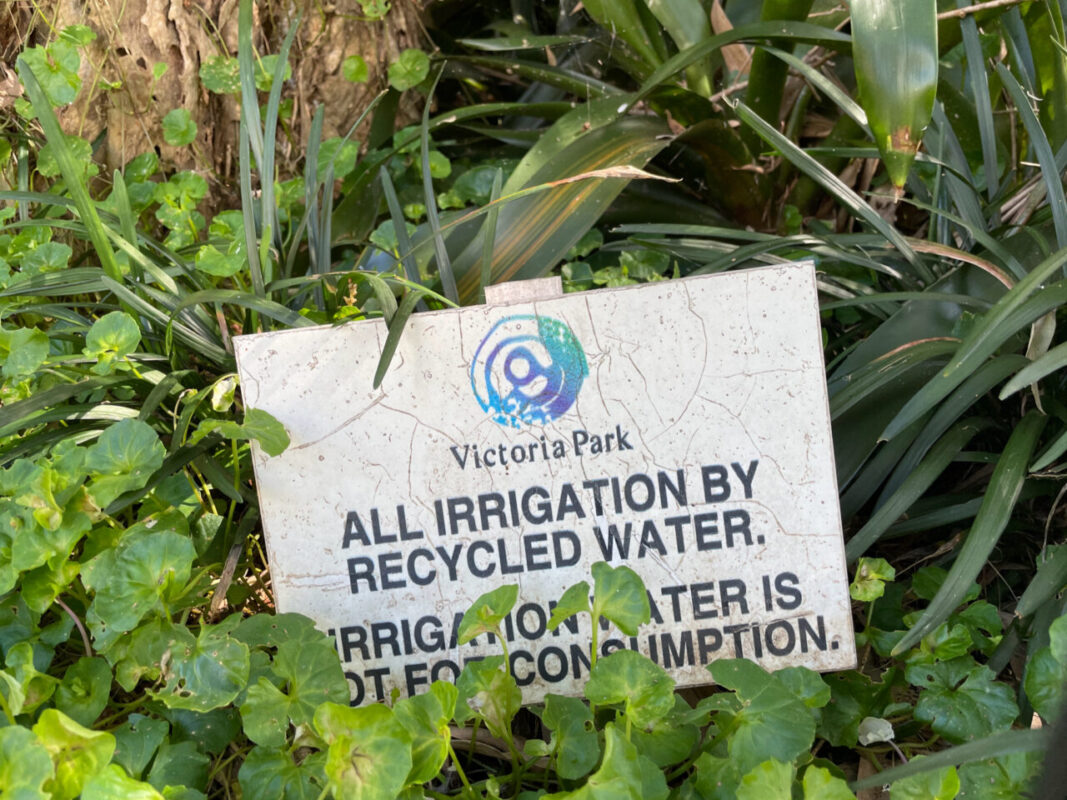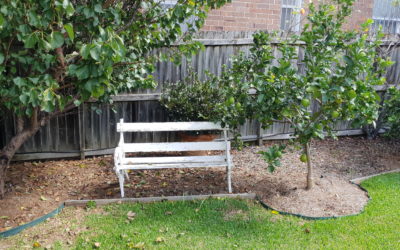Green Square Water Stories (2021-2023)
Funders: University of Technology Sydney Cross-faculty Initiative and UTS 2027 Strategy (2021), The Council of the City of Sydney (2022-2024)
Partners: Bangawarra, 107 Green Square, PedalSetGo
Download the Green Square Atlas of Water Stories
Download the Green Square Map of Water Stories
Download the Green Square Water Stories Case Study
Water Stories foregrounds histories, initiatives, and practices relating to water as a way of materialising social-ecological connections. Water Stories researches and develops an interactive installation that maps, materialises and activates social and environmental histories and practices centred around water in Green Square.
The Story

- Sustainability of urban areas depends on good water management, which is the result of infrastructures and civic ecologies, i.e. grassroots stewardship initiatives.
- The absence of water narratives plays a role in the deficit narrative of Green Square as a site lacking civic ecologies.
- Water has been and is fundamental in histories of social and environmental change in the area.
, Map – Parishes of Alexandria and Petersham, circa 1886-1889, City of Sydney Archives.
Water Stories addresses the complex issues outlined above by researching and developing an interactive installation that maps, materialises and activates social and environmental histories and practices centred around water in Green Square. In detail:
Conducts historical and ethnographic research on water and civic ecologies.
Makes them present and visible in an interactive installation.
Expands placemaking practices by surfacing water stories enmeshed in Green Square, yet forgotten in prevailing representations of Green Square.
Challenges the deficit narrative of Green Square by amplifying the presence of civic ecologies.
Offers a means of conceptualising urban renewal as a socioecological process, where social experience is embedded in the dynamics of ecology and vice versa.

Projects such as the recognition of the importance of water for the Aboriginal peoples in the area through artworks such as Aunty Julie Freeman and Jonathan Jones Bangala; signposting of wetlands; toponomy; the new stormwater drain redirecting water to Sheas Creek; and environmental public art like High Water are some of the ways in which water is managed and foregrounded in Green Square. Other, undocumented, examples include grass root practices, such as water recycling, grey water and rainwater harvesting, drought resistant gardening.


By connecting and materialising civic ecologies of water such practices are made more visible to diverse publics. This is important because materialising and making visible examples of organised or self organised, locally driven forms of water stewardship is a crucial step to establish a connection between people and places.
These connections cultivate a sense of belonging and generate local forms of care in the face of rapid and disruptive change. They also offer a means of charting urban civic ecology, moving it to the centre of urban development, rather than consigned it as a residue. With the growing ‘revenge’ of transformed ecology, not least in terms of storms and floods under climate change, the project explores a prospective agenda with wide significance.
Community participation is key to this project. Get involved and join us for community walks and workshops and share your knowledge of local environmental practices. If you live or work in Green Square, please consider taking part in our Questionnaire
Related Posts
Judging the Haberfield Gardens Competition 2019
Mapping Edges was invited to judge this year’s Haberfield Garden Competition. We walked with Inner West Greens Councillor Marghanita da Cruz looking at gardens in the ‘Kitchen’ and ‘Autumn’ categories.
The Haberfield Street Seed Library
The Haberfield Street Seed Library opened on Thursday 11 April. Seed saving is a well established practice among gardeners: some plants are left to go to...
Haberfield gardening: a conversation with Jeff Maylon
My interest in gardening started when I bought a little house in Ashfield. I made a decision then to live in my garden; it’s my castle. My wife doesn’t do a...
Responding to the garden: a conversation with Takis Constantopedos
Responding to a resilient garden: a conversation with Takis Constantopedos, 21 February 2018 This is a resilient garden: we are sitting at Takis’ kitchen...
Learning from neighbours: a conversation with Gordon and Rina
Rina: I grew up in Blacktown, where my parents settled after coming from Holland. My father was a very keen vegetable grower because he wanted to grow enough...
Plants that know where to grow: a conversation with Aine and Barry
Aine: We are not really avid gardeners. It’s happenstance. We try things. If a plant doesn't work, we move it somewhere else. Then we try something else. I...
Combining colour and scent: a conversation with Jean Kidd
I wanted it to be a pretty garden, with roses. I wanted pinks and mauves. So many of the plants are for the colour. I'm not a native plant person. I like...
Walk 1 – Banana
Walk 2 – Papaya
Walk 3 – Dragon Fruit
Trees, urban gardening and the importance of birds: a conversation with Angie Gallinaro
Trees, urban gardening and the importance of birds: a conversation with Angie Gallinaro. Trees, birds and garden design experiments: Angie Gallinaro spoke...
The garden suburb: a conversation with Vincent Crow
The garden suburb: a conversation with Vincent Crow We sat with Vincent Crow, historian, at the kitchen table in his Federation house in Haberfield. Vince...













